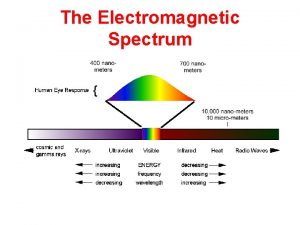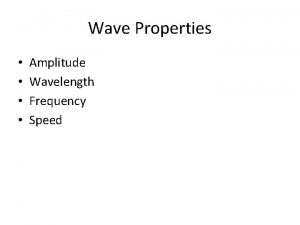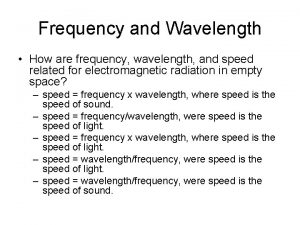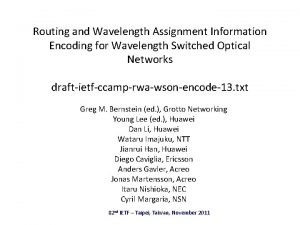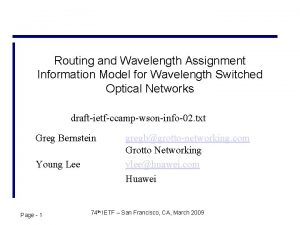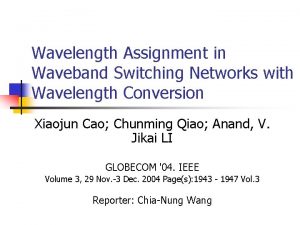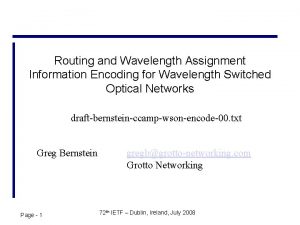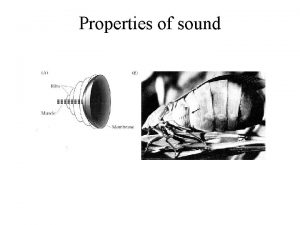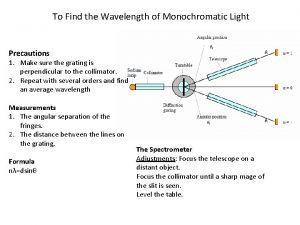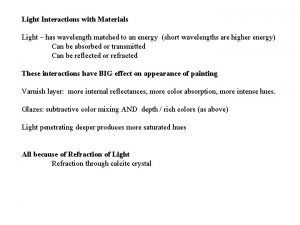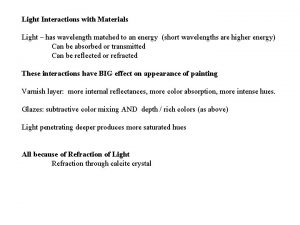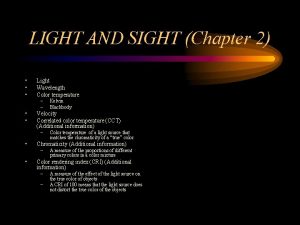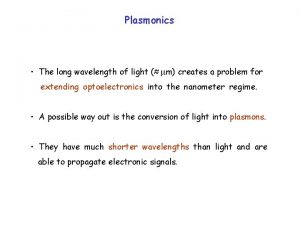Q 1 1 Find the wavelength of light





















- Slides: 21

Q 1. 1 Find the wavelength of light used in this 2 - slits interference. Note: Not drawn to scale. A. 3. 16 mm B. 0. 666 mm C. 0. 000633 mm D. 0. 200 mm Ans: λ=633 nm (typical of red He-Ne laser) Copyright © 2012 Pearson Education Inc.

Phasor review Will need phasors to understand diffraction gratings. Copyright © 2012 Pearson Education Inc.

Diffraction grating and the sun (first gateway to QM) Joseph von Fraunhofer (1787 -1826) The spectrum is not continuous ! Copyright © 2012 Pearson Education Inc. Unexpected dark lines due to the absorption of elements in the sun’s atmosphere. In the 20 th century it was realized that atomic energies are quantized.

Crystallography by X-ray diffraction First x-ray diffraction image of DNA by Rosalind Franklin (Fig 36. 24 of the text) Protein x-ray crystallography setup at the SLAC LCLS (Linac Coherent Light Source) in Stanford, CA. Other similar facilities in Hamburg Germany and Harima Science City, Japan Copyright © 2012 Pearson Education Inc.

Goals for Chapter 36 (Diffraction) • To see how a sharp edge or an aperture affect light • To analyze single-slit diffraction and calculate the intensity of the light • To investigate the effect on light of many closely spaced slits • To learn how scientists use diffraction gratings (e. g. in astrophysics) • To see what x-ray diffraction tells us about crystals, proteins… • To learn how diffraction places limits on the resolution of a telescope • Holograms ! Copyright © 2012 Pearson Education Inc.

Diffraction, Chapter 36 What is Diffraction: the process by which a beam of light or other system of waves is spread out as a result of passing through a narrow aperture or across an edge, typically accompanied by interference between the wave forms produced. A picture helps Copyright © 2012 Pearson Education Inc. Diffraction of water waves

Diffraction from a single slit (Physical Optics) • In the Figure below, the prediction of geometric optics in (a) does not occur. Instead, a diffraction pattern is produced, as in (b). Geometric optics Physical Optics • The narrower the slit, the broader the diffraction pattern. • Light is a wave (EM waves) and hence diffracts. • Diffraction phenomena also occur for EM waves, sound, electrons Copyright © 2012 Pearson Education Inc. (QM)

Diffraction What physical parameters control whether single slit diffraction occurs ? Ans: λ (wavelength), a (slit spacing). But this is not the full story. Ans: 2 nd part, distance to the screen (near field, Fresnel diffraction) and (far field, Fraunhofer diffraction) Copyright © 2012 Pearson Education Inc.

Diffraction • According to geometric optics, a light source shining on an object in front of a screen should cast a sharp shadow. Surprisingly, this does not occur because of diffraction. Copyright © 2012 Pearson Education Inc.

Diffraction and Huygen’s Principle • Huygens’s principle can be used to analyze diffraction. • Fresnel diffraction: Source, screen, and obstacle are close together. • Fraunhofer diffraction: Source, screen, and obstacle are far apart. • The figure below shows the diffraction pattern of a razor blade. Copyright © 2012 Pearson Education Inc.

Diffraction and Huygen’s Principle • What is Huygens’s principle ? The Huygens-Fresnel principle states that every point on a wavefront is a source of wavelets. These wavelets spread out in the forward direction, at the same speed as the source wave. The new wavefront is a line tangent to all of the wavelets. So what is interfering in single slit diffraction ? Copyright © 2012 Pearson Education Inc.

Fresnel and Fraunhofer diffraction by a single slit • The figure below shows Fresnel (near-field) and Frauenhofer (far-field) diffraction for a single slit. Copyright © 2012 Pearson Education Inc.

Locating the dark fringes • Review the single-slit diffraction discussion in the text. • The figure below shows the geometry for single slit Fraunhofer diffraction. (Imagine the aperture is made of many tiny slits). What is the path difference between the two strips ? Ans: path difference =a/2 sin(θ) If path difference to P is λ/2, what do we see at Point P ? Copyright © 2012 Pearson Education Inc. Dark fringe

Locating the dark fringes in single slit diffraction In general, at what angles do we find the dark fringes ? Ans: If path difference to P is mλ/2, we will find dark fringes Dark fringes Copyright © 2012 Pearson Education Inc.

Locating the dark fringes in the single slit diffraction pattern Copyright © 2012 Pearson Education Inc.

Examples of single-slit diffraction • The figure on the left is a photograph of a Fraunhofer pattern of a single horizontal slit. What features are especially notable ? • Example 36. 1: You pass 633 -nm light through a narrow slit and observe the diffraction pattern on a screen 6. 0 m away. The distance at the screen between the center and the first minima on either side is 32 mm long. How wide is the slit? Copyright © 2012 Pearson Education Inc.

Intensity in the single-slit pattern • Follow the text’s discussion of the intensity in the single-slit pattern using the phasor diagrams below. Copyright © 2012 Pearson Education Inc.

Quantitative Intensity in the single-slit pattern • The angle b is the phase angle of the ray from the top of the slit, while the phase angle from the bottom of the slit is 0. The vectors lie along a circle whose center is at C, so Ep is a chord of the circle. The arc length E 0 is subtended by this same angle b, so the radius of the circle is E 0/b. • From the diagram, • Since • We have (sinc function) Copyright © 2012 Pearson Education Inc.

Quantitative Intensity in the single-slit diffraction pattern Intensity of a single slit diffraction pattern Copyright © 2012 Pearson Education Inc.

Intensity maxima in a single-slit pattern • The figure on the right shows the intensity versus angle in a single-slit diffraction pattern. • The minima occur when β is a multiple of 2π, i. e. at • The location of the maxima are found by taking the derivative of and setting it to zero. Surprisingly, these are not precisely where • In fact, there are no maxima for m = 0 in this expression. The central maximum is wider than the others, and occurs at q = 0. • Using these approximate values of β in the intensity, we find Copyright © 2012 Pearson Education Inc.

Width of the single-slit pattern • The width of the single-slit diffraction pattern depends on the ratio of the slit width a to the wavelength λ. Copyright © 2012 Pearson Education Inc.
 Longest wavelength to shortest wavelength
Longest wavelength to shortest wavelength Light light light chapter 23
Light light light chapter 23 Into the light chapter 22
Into the light chapter 22 Chapter 22
Chapter 22 Which wave has the lowest frequency
Which wave has the lowest frequency Light intensity calculator
Light intensity calculator Wavelength of light
Wavelength of light Em spektrum
Em spektrum How to find wavelength from frequency
How to find wavelength from frequency Frequency equation wavelength
Frequency equation wavelength Put out the light
Put out the light Bacteria double membrane
Bacteria double membrane Bouncing off of light
Bouncing off of light Materials block light
Materials block light Hình ảnh bộ gõ cơ thể búng tay
Hình ảnh bộ gõ cơ thể búng tay Frameset trong html5
Frameset trong html5 Bổ thể
Bổ thể Tỉ lệ cơ thể trẻ em
Tỉ lệ cơ thể trẻ em Voi kéo gỗ như thế nào
Voi kéo gỗ như thế nào Chụp tư thế worms-breton
Chụp tư thế worms-breton Chúa yêu trần thế alleluia
Chúa yêu trần thế alleluia Các môn thể thao bắt đầu bằng tiếng chạy
Các môn thể thao bắt đầu bằng tiếng chạy
